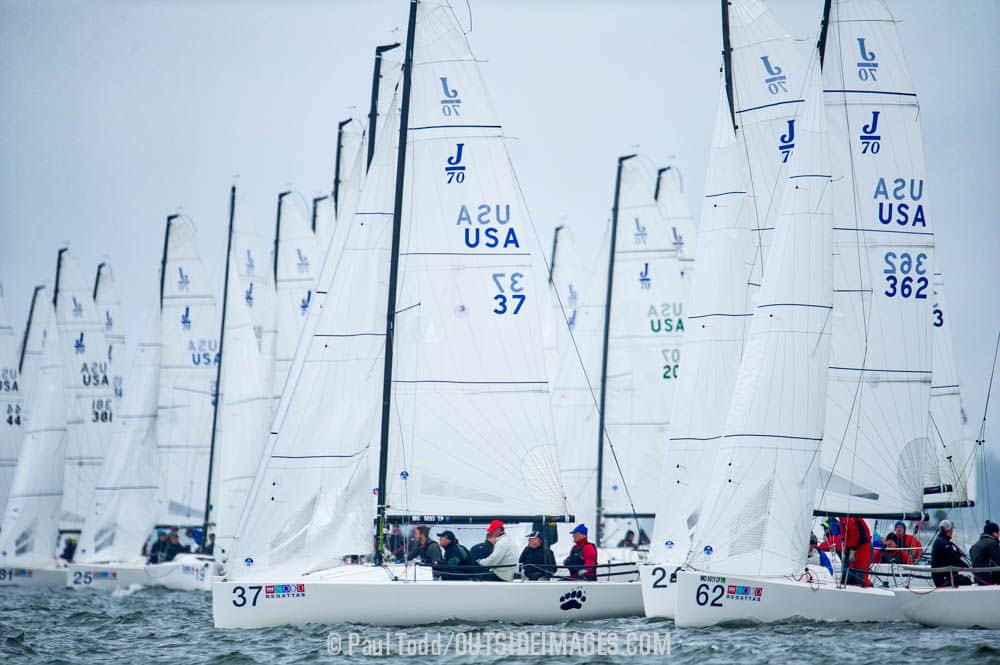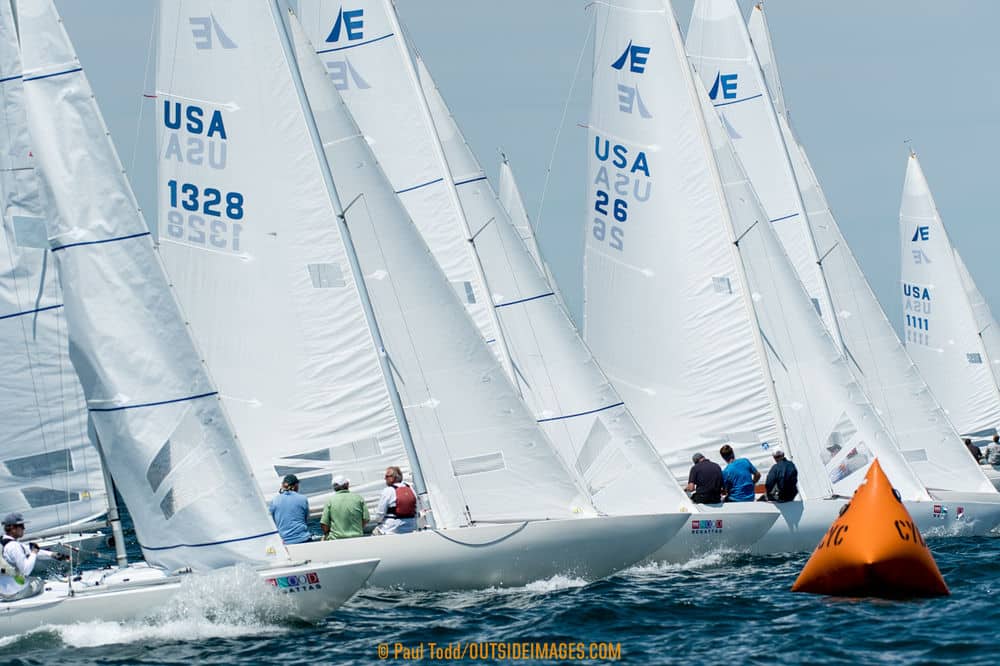
We prepared to start the final race of the two-day Severn Sailing Association Soling Summer Series at about 2 p.m. on a warm July afternoon. Our lead was precarious. If we failed to beat Peter Gleitz in this race, we would fall into a tie, which would be broken in his favor. This was the third of three short, windward-leeward races, using the same unaltered line in an amalgamated sea breeze—a mixture of the local sea breeze and the ocean sea breeze coming overland and onto the bay from off the Eastern Shore.
Before the start of the final race, the wind had been in a prolonged back (at around 150 degrees) for four to five minutes, and the pin end of the line had become heavily favored. I asked myself and the crew whether I should start on port on the lifted tack or make my usual pin end start and then tack. I presumed that with a good start at the pin, I would have the nearest boats in my bad air and would soon thereafter be able to tack and cross the fleet. The gain I would make by starting ahead would put me in control of Peter from the outset.
I made the start at the pin alright, but because another boat had tried to drive through to leeward, I had needed to go down below the layline with speed, come up in a sharp luff and, in the last 8 seconds, bear away, hold below the buoy, and start without a foot to spare. So I was slow and low at first and had to sail about 100 yards in the header before the boat on my hip tacked. But the back was holding, and we looked great, at least for a minute or two. Then, as the wind gradually veered, I could see that Peter, who had started up the line and had tacked to port immediately, was working out on my leebow. He tacked on the layline and crossed us by three boatlengths.
We couldn’t tack to port, so we continued, our only hope being the possibility that the back would return before we reached the port layline. It did, and we tacked. For a moment, I thought we’d have him. But no, the wind gradually veered to its median position, and, near the mark, he crossed two boatlengths ahead. And there went the Summer Series. Now, if I’d hit those shifts in a different sequence—if I’d used a different jib and had been faster, if I’d been faster downwind—if, if, if. And the biggest if was: if the beats had only been longer. On short, half-mile legs, there’s typically time for but one shift of an oscillating series, and that one shift becomes a persistent shift. If (at the average speed of a racing sailboat, five knots) it takes about eight to nine minutes to sail a half-mile beat, and if oscillating shifts occur about once every five to eight minutes, it’s unlikely that more than one shift will occur during a beat. If the shift extant at the start persists for two or more minutes after the start, then the first shift of the beat is almost certain to be the only shift.

On a long leg with frequent shifts, all you need to do is start on the lifted tack, tack when headed beyond the median wind direction, and sail another lifted tack until you reach another header. Classic Category I oscillating wind strategy. Simple. But if the leg is short and/or the oscillating shifts are infrequent, and you start at the favored end of the line on the headed tack, you may never catch up!
Consequently, strategy for short legs and infrequent shifts must be based on moving immediately toward the side of the course from which the first shift will emanate. There may never be another! The problem is, of course, to determine which side that will be, and the solution is to select the side opposite the direction of the shift extant.
The conduct of the first few minutes of a short race, between the start and the first shift, determines where the boats will be when the first crucial shift occurs, and therefore, who will gain relative to all the others. Big gains or losses are made at that moment, and on a short leg, they will persist for the remainder of the leg or, at least until near its completion. And even if another shift occurs, there will be little time for the advantaged boats to consolidate their gains. Thus, the boat that gains the most in the first shift is typically the winner.
Of course, if one is to start in the direction of the next shift, one must monitor the wind before the start and particularly during the final few minutes. Many sailors do this merely by luffing head to wind on the line, sighting in each direction and judging toward which end the boat is headed. But this technique provides no insight into subsequent shifts. It is far better to obtain the compass direction of the line (by sighting from one end or the other, or by sighting along the boat’s centerline when sailing along it), and compare that heading with the wind direction detected by luffing (and to calculate the direction that causes the line to become square). This knowledge permits a subsequent shift to be detected by a brief luff head-to-wind, a maneuver easily accomplished during the minutes before a start, and a comparison of the new wind direction with the previous. A reasonable alternative is to judge the difference in trim resulting when reaching parallel to the line in one direction and in the other, and to note (while reaching back and forth) subsequent changes in that trim. Armed with this information (and being alert to the possibility that the committee is adjusting the line), one can determine the shift extant at the start, and, if the course is short and/or the shift frequency long, arrange to start at the end of the line opposite that shift, typically opposite the favored end.
If a back (a shift left) is evident before the start, start at the right end of the line, to windward of your opponents, and tack toward the veer to come (and vice versa). If only one shift transpires, you will win. If two, chances are that the first will be of greater duration, and you will make a net gain; if three, you will have benefited from two shifts in your direction visa- vis your opponent’s one and will win. When there is time for only a few shiffs, bet on getting the first one right!
If the windward leg is short or the oscillating shiffs are of long duration, where you start on the line relative to other boats, and the length of the starting line, matter. The gain achieved by starting at the upwind end of a short line (typical of short races) is overwhelmed by even a slight shift toward a boat at the initially downwind end. This maxim is particularly applicable when racing against one other boat (and explains why, in match racing, the boats are preoccupied with starting nearer to the side from which they expect the next shift to emanate).
Starting at the upwind (favored) end of the line is appropriate in Category III Conditions, when there is no favored side of the course, but it is altogether inappropriate in Category II Conditions, when one side, obviously advantaged, and in Category I Conditions when the wind is oscillating, the leg is short and/or the shifts are infrequent. I lost the SSA Summer Series by starting the final race at the favored, pin end of the line and allowing my opponent to start to my right, nearer the side from which the next shift would emanate.









